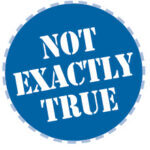Common Misunderstandings
Dystonia is a Movement Disorder
Dystonia is a neurological disorder that occurs with a variety of symptoms, characteristics, and causes.
Incorrect information about dystonia is easy to find, not just on the internet but in media stories
and even from sources that claim to be authorities on dystonia.
It can be challenging to identify credible sources for information.
Here we clarify several common misunderstandings about dystonia.

There is a gene for dystonia.
REALITY: The genetics of dystonia are complicated. There is no single gene responsible for all cases of dystonia. Approximately 200 genes or genetic markers have been associated with different types of dystonia. And it is inevitable that new genes will be discovered in the future. It must be emphasized also that carrying a gene for dystonia does not necessarily mean that an individuals will develop dystonia.

There is one genetic test for dystonia. You either have the genetic mutation or you don’t.
REALITY: Researchers have found that mutations in a number of specific genes cause dystonia. However, right now it is only possible to test for a handful of these mutated genes. There is not a genetic test available for every form of dystonia. Most people who are diagnosed with dystonia will not test positive for a known dystonia-causing mutation, and only a percentage of those who do will ever develop symptoms.

DYT1 dystonia is the most common.
REALITY: DYT1 dystonia is a primary torsion dystonia (sometimes referred to as early onset or childhood onset dystonia). It is among the best understood forms of the disorder, but it is not the most common. Focal dystonias that begin in adulthood are believed to be the most common. These include cervical dystonia, blepharospasm, focal hand or foot dystonia, oromandibular dystonia, and spasmodic dysphonia/laryngeal dystonia.

Little is known about the cause of dystonia.
REALITY: Although for most people with dystonia there is no obvious cause to be found, experts have shown that the disorder can be caused by a staggeringly diverse variety of factors and conditions. These include genetic mutations, exposure to certain drugs, brain injury or infection, and within the context of numerous different disorders. Although this diversity presents challenges to the research field, it also provides opportunities to look for commonalities among these factors that may point to common mechanisms.

Dystonia is a muscle problem only.
REALITY: While dystonia manifests as abnormal muscle contractions, numerous studies have shown that the abnormality in patients with dystonia is found in the brain. Furthermore, for some types of dystonia, especially DYT1 dystonia, deep brain stimulation (DBS) is the most effective means of treatment, which speaks to the origins in the brain.

Botulinum neurotoxin injections are unsafe.
REALITY: It may be confusing that a treatment includes the word “toxin” in its name. Botulinum neurotoxin injections have decades of research demonstrating that they are a safe and effective medical treatment. Botulinum neurotoxin has been approved for use in the United States since 1989, and treatment for dystonia was among the earliest medical uses. When provided by a knowledgeable and experienced doctor, botulinum neurotoxin injections often greatly benefit function, reduce pain, and improve quality of life. It must be emphasized that botulinum neurotoxin treats the symptoms of dystonia but does not result in a cure. Treatment effects may also vary within the same individual across time, and experienced doctors may adjust dose or switch to an alternative toxin type.

No research is being done in dystonia.
REALITY: Investigators all over the world are working to better understand dystonia and develop improved treatments—and ultimately a cure. These research investigators are supported by private organizations such as the DMRF and government institutions such as the National Institutes of Health and the Department of Defense. However, there are more opportunities for advancement in dystonia research right now than there is funding to invest—which makes the role of organizations like the DMRF more important than ever. Funding is the fuel that keeps progress in dystonia moving forward.

Vaccinations cause dystonia.
REALITY: There is no evidence that vaccinations cause dystonia. The DMRF asked a panel of preeminent movement disorder experts to examine this closely several years ago when a story surfaced of a woman who claimed to have developed “dystonia” following a flu immunization. It was later established the dystonia diagnosis was not correct. In contrast, preliminary research suggests certain vaccinations may actually be protective against certain forms of dystonia. As with any medical procedure, the DMRF encourages individuals to discuss the risks and benefits of immunizations with their doctors.

No new treatments for dystonia are being explored.
REALITY: Improved treatments are a major focus of the DMRF’s research efforts, including partnering with drug companies to discover new targets for medications, uncovering new treatment approaches, and funding investigators who are working to make existing treatments more effective. Meanwhile, advances in medical and research technology may reveal new treatment opportunities, and unexpected discoveries can happen any time through basic research. Treatment for dystonia will continue to improve as the research progresses.
If you have questions about medical information you encounter online or in the media, contact your doctor’s office. The DMRF website offers a wealth of information about dystonia and related topics.



